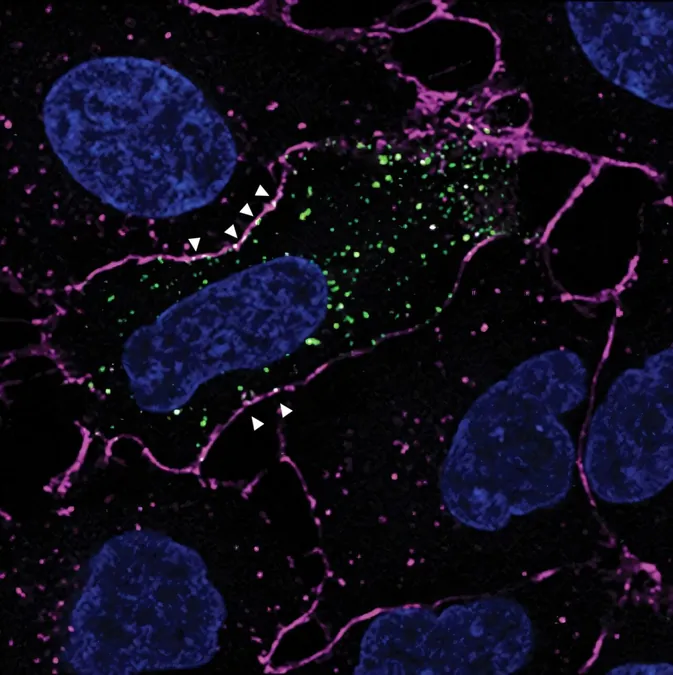
Unveiling the Secrets of Camouflage in Alpine Corydalis Plants - A Remarkable Survival Strategy!
2025-04-02
Author: Sarah
Introduction
Camouflage isn’t just for animals; it’s a vital defensive mechanism for some plant species too! A striking revelation has emerged from a collaborative study by the Kunming Institute of Botany and Lanzhou University, detailing the genetic foundation of camouflage in alpine Corydalis plants, which thrive in the rugged Qinghai-Tibet Plateau.
The Environment and Camouflage
In this extraordinary region, where the environment is an extreme challenge due to high altitudes exceeding 4,000 meters, over 40% of alpine plant species showcase a stunning camouflage – mimicking the rocky substrates they grow on. This remarkable ability isn’t merely aesthetic; it allows these plants to evade herbivores and establish themselves in harsh, competitive landscapes.
Mimicking Rocky Surroundings
The researchers found that these specialized Corydalis species display leafy colors that seamlessly blend with their rocky surroundings, effectively rendering themselves invisible to the prying eyes of herbivores. This extraordinary evolutionary advantage earns them the title “masters of camouflage.” Intriguingly, these plants serve a crucial ecological role as hosts for Parnassius butterflies, which rely on Corydalis for their larvae to thrive. The butterflies’ visual recognition of host plants is a pivotal factor that has influenced the evolution of such cryptic coloration.
Genetic Insights
Researchers conducted extensive analyses, revealing that the leaf color in Corydalis species varies according to local rock formations, enhancing survival while maintaining efficient photosynthesis. Through their findings, they discovered that the camouflaged leaves of these plants have higher anthocyanin levels, the pigments responsible for their striking coloration.
The Role of Leaf-Color Dimorphism
Delving deeper, the study employed leaf-color dimorphism – the co-existence of camouflaged and green morphs – to pinpoint the genetic mechanisms behind this remarkable adaptation. By analyzing high-quality genomes of both morphs and integrating innovative transcriptomic and metabolomic studies, a significant discovery was made: a specific 254-bp transposon insertion in the bHLH35 gene correlates strongly with leaf camouflage. This insertion enhances transcriptional activity, leading to increased anthocyanin synthesis and, consequently, the rock-like gray color of the leaves!
Experimental Validation
Using cutting-edge technology, researchers crafted decoy leaves via 3D printing to assess the effectiveness of camouflage against the keen eyes of Parnassius butterflies. Shockingly, the experiment revealed that butterflies preferred to lay their eggs on green plants rather than their camouflaged counterparts. In nature, plants sporting this camouflage faced significantly less herbivory, boosting their fruit sets and reproductive success.
Climate Change and Speciation
Analyzing climatic trends and the effective population sizes of both Corydalis and Parnassius butterflies over the last 500 years unveiled a fascinating “mirror fluctuation” pattern: during warm climate periods, green plant populations plummeted while butterfly numbers remained steady. Conversely, camouflaged plants exhibited resilience, ensuring their survival amidst fluctuating climate conditions, even as Parnassius butterfly populations witnessed a decline.
Conclusion
This groundbreaking research not only sheds light on the genetic basis of camouflage in plants but also highlights the complex interdependence of species and the unforeseen impacts of climate change on their survival. The implications are enormous, expanding our understanding of plant evolution and ecology in a rapidly changing world! Keep an eye on the natural world around you; you might just spot these masters of disguise!


 Brasil (PT)
Brasil (PT)
 Canada (EN)
Canada (EN)
 Chile (ES)
Chile (ES)
 Česko (CS)
Česko (CS)
 대한민국 (KO)
대한민국 (KO)
 España (ES)
España (ES)
 France (FR)
France (FR)
 Hong Kong (EN)
Hong Kong (EN)
 Italia (IT)
Italia (IT)
 日本 (JA)
日本 (JA)
 Magyarország (HU)
Magyarország (HU)
 Norge (NO)
Norge (NO)
 Polska (PL)
Polska (PL)
 Schweiz (DE)
Schweiz (DE)
 Singapore (EN)
Singapore (EN)
 Sverige (SV)
Sverige (SV)
 Suomi (FI)
Suomi (FI)
 Türkiye (TR)
Türkiye (TR)
 الإمارات العربية المتحدة (AR)
الإمارات العربية المتحدة (AR)